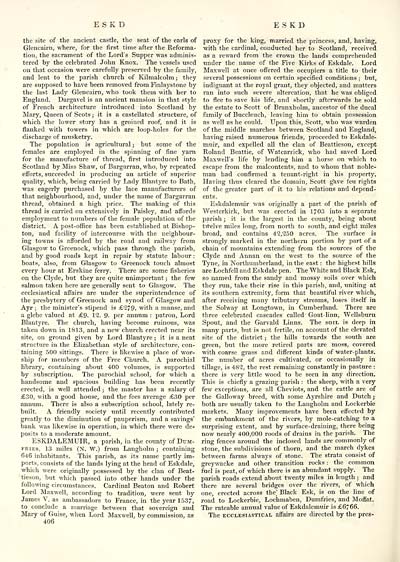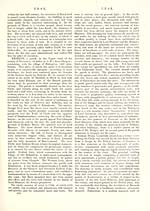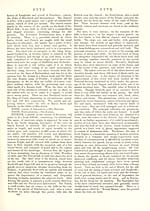Topographical dictionary of Scotland > Volume 1
(420) Page 406 - ERS
Download files
Complete book:
Individual page:
Thumbnail gallery: Grid view | List view

E S K D
E S KD
the site of the ancient castle, the seat of the earls of
Glencairn, where, for the first time after the Reforma-
tion, the sacrament of the Lord's Supper was adminis-
tered by the celebrated John Knox. The vessels used
on that occasion were carefully preserved by the family,
and lent to the parish church of Kilmalcolm ; they
are supposed to have been removed from Finlaystone by
the last Lady Glencairn, who took them with her to
England. Dargavel is an ancient mansion in that style
of French architecture introduced into Scotland by
Mary, Queen of Scots ; it is a castellated structure, of
which the lower story has a groined roof, and it is
flanked with towers in which are loop-holes for the
discharge of musketry.
The population is agricultural ; but some of the
females are employed in the spinning of fine yarn
for the manufacture of thread, first introduced into
Scotland by Miss Shaw, of Bargarran, who, by repeated
efforts, succeeded in producing an article of superior
quality, which, being carried by Lady Blantyre to Bath,
was eagerly purchased by the lace manufacturers of
that neighbourhood, and, under the name of Bargarran
thread, obtained a high price. The making of this
thread is carried on extensively in Paisley, and affords
employment to numbers of the female population of the
district. A post-office has been established at Bishop-
ton, and facility of intercourse with the neighbour-
ing towns is afforded by the road and railway from
Glasgow to Greenock, which pass through the parish,
and by good roads kept in repair by statute labour :
boats, also, from Glasgow to Greenock touch almost
every hour at Erskine ferry. There are some fisheries
on the Clyde, but they are quite unimportant ; the few
salmon taken here are generally sent to Glasgow. The
ecclesiastical affairs are under the superintendence of
the presbytery of Greenock and synod of Glasgow and
Ayr ; the minister's stipend is £279, with a manse, and
a glebe valued at £9. 12. 9- per annum : patron, Lord
Blantyre. The church, having become ruinous, was
taken down in IS 13, and a new church erected near its
site, on ground given by Lord Blantyre ; it is a neat
structure in the Elizabethan style of architecture, con-
taining 500 sittings. There is likewise a place of wor-
ship for members of the Free Church. A parochial
library, containing about 400 volumes, is supported
by subscription. The parochial school, for which a
handsome and spacious building has been recently
erected, is well attended ; the master has a salary of
£30, with a good house, and the fees average £30 per
annum. There is also a subscription school, lately re-
built. A friendly society until recently contributed
greatly to the diminution of pauperism, and a savings'
bank was likewise in operation, in which there were de-
posits to a moderate amount.
ESKDALEMUIR, a parish, in the county of Dum-
fries, 13 miles (N. W.) from Langholm ; containing
646 inhabitants. This parish, as its name partly im-
ports, consists of the lands lying at the head of Eskdale,
which were originally possessed by the clan of Beat-
tieson, but which passed into other hands under the
following circumstances. Cardinal Beaton and Robert
Lord Maxwell, according to tradition, were sent by
James V. as ambassadors to France, in the year 1537,
to conclude a marriage between that sovereign and
Mary of Guise, when Lord Maxwell, by commission, as
406
proxy for the king, married the princess, and, having,
with the cardinal, conducted her to Scotland, received
as a reward from the crown the lands comprehended
under the name of the Five Kirks of Eskdale. Lord
Maxwell at once offered the occupiers a title to their
several possessions on certain specified conditions ; but,
indignant at the royal grant, they objected, and matters
ran into such severe altercation, that he was obliged
to flee to save his life, and shortly afterwards he sold
the estate to Scott of Branxholm, ancestor of the ducal
family of Buccleuch, leaving him to obtain possession
as well as he could. Upon this, Scott, who was warden
of the middle marches between Scotland and England,
having raised numerous friends, proceeded to Eskdale-
muir, and expelled all the clan of Beattieson, except
Roland Beattie, of Watcarrick, who had saved Lord
Maxwell's life by lending him a horse on which to
escape from the malcontents, and to whom that noble-
man had confirmed a tenant-right in his property.
Having thus cleared the domain, Scott g'ave feu rights
of the greater part of it to his relations and depend-
ents.
Eskdalemuir was originally a part of the parish of
Westerkirk, but was erected in 1/03 into a separate
parish ; it is the largest in the county, being about
twelve miles long, from north to south, and eight miles
broad, and contains 42,250 acres. The surface is
strongly marked in the northern portion by part of a
chain of mountains extending from the sources of the
Clyde and Annan on the west to the source of the
Tyne, in Northumberland, in the east : the highest hills
are Lochfell and Eskdale pen. The White and Black Esk,
so named from the sandy and mossy soils over which
they run, take their rise in this parish, and, uniting at
its southern extremity, form that beautiful river which,
after receiving many tributary streams, loses itself in
the Solway at Longtown, in Cumberland. There are
three celebrated cascades called Goat-linn, Wellsburn
Spout, and the Garvald Linns. The soil is deep in
many parts, but is not fertile, on account of the elevated
site of the district ; the hills towards the south are
green, but the more retired parts are moss, covered
with coarse grass and different kinds of water-plants.
The number of acres cultivated, or occasionally in
tillage, is 482, the rest remaining constantly in pasture :
there is very little wood to be seen in any direction.
This is chiefly a grazing parish : the sheep, with a very
few exceptions, are all Cheviots, and the cattle are of
the Galloway breed, with some Ayrshire and Dutch ;
both are usually taken to the Langholm and Lockerbie
markets. Many improvements have been effected by
the embankment of the rivers, by mole-catching to a
surprising extent, and by surface-draining, there being
now nearly 400,000 roods of drains in the parish. The
ring fences around the inclosed lands are commonly of
stone, the subdivisions of thorn, and the march dykes
between farms always of stone. The strata consist of
greywacke and other transition rocks ; the common
fuel is peat, of which there is an abundant supply. The
parish roads extend about twenty miles in length ; and
there are several bridges over the rivers, of which
one, erected across the; Black Esk, is on the line of
road to Lockerbie, Lochmaben, Dumfries, and Moffat.
The rateable annual value of Eskdalemuir is £6766.
The ecclesiastical affairs are directed by the pres-
E S KD
the site of the ancient castle, the seat of the earls of
Glencairn, where, for the first time after the Reforma-
tion, the sacrament of the Lord's Supper was adminis-
tered by the celebrated John Knox. The vessels used
on that occasion were carefully preserved by the family,
and lent to the parish church of Kilmalcolm ; they
are supposed to have been removed from Finlaystone by
the last Lady Glencairn, who took them with her to
England. Dargavel is an ancient mansion in that style
of French architecture introduced into Scotland by
Mary, Queen of Scots ; it is a castellated structure, of
which the lower story has a groined roof, and it is
flanked with towers in which are loop-holes for the
discharge of musketry.
The population is agricultural ; but some of the
females are employed in the spinning of fine yarn
for the manufacture of thread, first introduced into
Scotland by Miss Shaw, of Bargarran, who, by repeated
efforts, succeeded in producing an article of superior
quality, which, being carried by Lady Blantyre to Bath,
was eagerly purchased by the lace manufacturers of
that neighbourhood, and, under the name of Bargarran
thread, obtained a high price. The making of this
thread is carried on extensively in Paisley, and affords
employment to numbers of the female population of the
district. A post-office has been established at Bishop-
ton, and facility of intercourse with the neighbour-
ing towns is afforded by the road and railway from
Glasgow to Greenock, which pass through the parish,
and by good roads kept in repair by statute labour :
boats, also, from Glasgow to Greenock touch almost
every hour at Erskine ferry. There are some fisheries
on the Clyde, but they are quite unimportant ; the few
salmon taken here are generally sent to Glasgow. The
ecclesiastical affairs are under the superintendence of
the presbytery of Greenock and synod of Glasgow and
Ayr ; the minister's stipend is £279, with a manse, and
a glebe valued at £9. 12. 9- per annum : patron, Lord
Blantyre. The church, having become ruinous, was
taken down in IS 13, and a new church erected near its
site, on ground given by Lord Blantyre ; it is a neat
structure in the Elizabethan style of architecture, con-
taining 500 sittings. There is likewise a place of wor-
ship for members of the Free Church. A parochial
library, containing about 400 volumes, is supported
by subscription. The parochial school, for which a
handsome and spacious building has been recently
erected, is well attended ; the master has a salary of
£30, with a good house, and the fees average £30 per
annum. There is also a subscription school, lately re-
built. A friendly society until recently contributed
greatly to the diminution of pauperism, and a savings'
bank was likewise in operation, in which there were de-
posits to a moderate amount.
ESKDALEMUIR, a parish, in the county of Dum-
fries, 13 miles (N. W.) from Langholm ; containing
646 inhabitants. This parish, as its name partly im-
ports, consists of the lands lying at the head of Eskdale,
which were originally possessed by the clan of Beat-
tieson, but which passed into other hands under the
following circumstances. Cardinal Beaton and Robert
Lord Maxwell, according to tradition, were sent by
James V. as ambassadors to France, in the year 1537,
to conclude a marriage between that sovereign and
Mary of Guise, when Lord Maxwell, by commission, as
406
proxy for the king, married the princess, and, having,
with the cardinal, conducted her to Scotland, received
as a reward from the crown the lands comprehended
under the name of the Five Kirks of Eskdale. Lord
Maxwell at once offered the occupiers a title to their
several possessions on certain specified conditions ; but,
indignant at the royal grant, they objected, and matters
ran into such severe altercation, that he was obliged
to flee to save his life, and shortly afterwards he sold
the estate to Scott of Branxholm, ancestor of the ducal
family of Buccleuch, leaving him to obtain possession
as well as he could. Upon this, Scott, who was warden
of the middle marches between Scotland and England,
having raised numerous friends, proceeded to Eskdale-
muir, and expelled all the clan of Beattieson, except
Roland Beattie, of Watcarrick, who had saved Lord
Maxwell's life by lending him a horse on which to
escape from the malcontents, and to whom that noble-
man had confirmed a tenant-right in his property.
Having thus cleared the domain, Scott g'ave feu rights
of the greater part of it to his relations and depend-
ents.
Eskdalemuir was originally a part of the parish of
Westerkirk, but was erected in 1/03 into a separate
parish ; it is the largest in the county, being about
twelve miles long, from north to south, and eight miles
broad, and contains 42,250 acres. The surface is
strongly marked in the northern portion by part of a
chain of mountains extending from the sources of the
Clyde and Annan on the west to the source of the
Tyne, in Northumberland, in the east : the highest hills
are Lochfell and Eskdale pen. The White and Black Esk,
so named from the sandy and mossy soils over which
they run, take their rise in this parish, and, uniting at
its southern extremity, form that beautiful river which,
after receiving many tributary streams, loses itself in
the Solway at Longtown, in Cumberland. There are
three celebrated cascades called Goat-linn, Wellsburn
Spout, and the Garvald Linns. The soil is deep in
many parts, but is not fertile, on account of the elevated
site of the district ; the hills towards the south are
green, but the more retired parts are moss, covered
with coarse grass and different kinds of water-plants.
The number of acres cultivated, or occasionally in
tillage, is 482, the rest remaining constantly in pasture :
there is very little wood to be seen in any direction.
This is chiefly a grazing parish : the sheep, with a very
few exceptions, are all Cheviots, and the cattle are of
the Galloway breed, with some Ayrshire and Dutch ;
both are usually taken to the Langholm and Lockerbie
markets. Many improvements have been effected by
the embankment of the rivers, by mole-catching to a
surprising extent, and by surface-draining, there being
now nearly 400,000 roods of drains in the parish. The
ring fences around the inclosed lands are commonly of
stone, the subdivisions of thorn, and the march dykes
between farms always of stone. The strata consist of
greywacke and other transition rocks ; the common
fuel is peat, of which there is an abundant supply. The
parish roads extend about twenty miles in length ; and
there are several bridges over the rivers, of which
one, erected across the; Black Esk, is on the line of
road to Lockerbie, Lochmaben, Dumfries, and Moffat.
The rateable annual value of Eskdalemuir is £6766.
The ecclesiastical affairs are directed by the pres-
Set display mode to: Large image | Transcription
Images and transcriptions on this page, including medium image downloads, may be used under the Creative Commons Attribution 4.0 International Licence unless otherwise stated. ![]()
| Gazetteers of Scotland, 1803-1901 > Topographical dictionary of Scotland > Volume 1 > (420) Page 406 - ERS |
|---|
| Permanent URL | https://digital.nls.uk/97487074 |
|---|
| Description | Volume I: From Abbey to Jura. |
|---|---|
| Attribution and copyright: |
|

